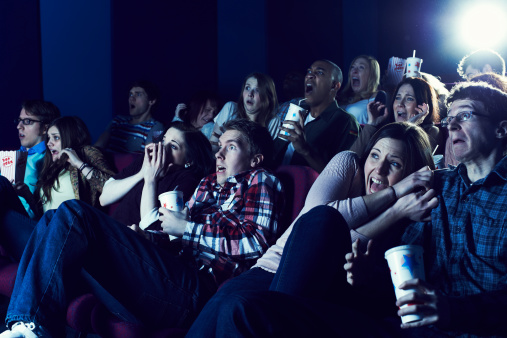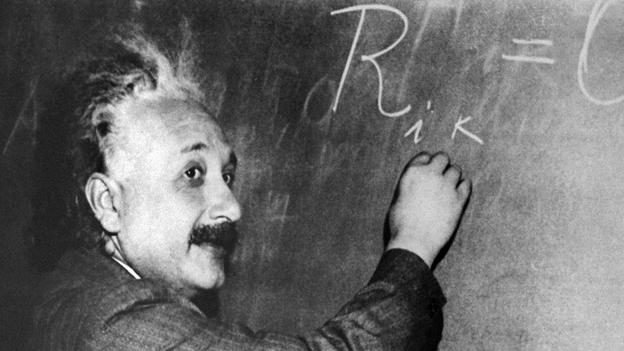Blog
- Brainwaves Can Predict Audience Reaction
- By Jason von Stietz
- July 31, 2014
-

Photo Credit: Getty Images Could EEG more accurately predict the general population's response to movies or television programming than self-reports? Researchers at The City College of New York found EEG to be a strong predicter. Finding's indicated that high agreement in study participants' EEG signified a positive response to what was being viewed. In contrast, low agreement in EEG indicated less enjoyment by the participants. Medical Xpress discussed the study in a recent article:
By analyzing the brainwaves of 16 individuals as they watched mainstream television content, researchers were able to accurately predict the preferences of large TV audiences, up to 90 % in the case of Super Bowl commercials. The findings appear in a paper entitled, "Audience Preferences Are Predicted by Temporal Reliability of Neural Processing," published July 29, 2014, in Nature Communications.
"Alternative methods, such as self-reports are fraught with problems as people conform their responses to their own values and expectations," said Dr. Jacek Dmochowski, lead author of the paper and a postdoctoral fellow at City College during the research. However, brain signals measured using electroencephalography (EEG) can, in principle, alleviate this shortcoming by providing immediate physiological responses immune to such self-biasing. "Our findings show that these immediate responses are in fact closely tied to the subsequent behavior of the general population," he added.
Dr. Lucas Parra, Herbert Kayser Professor of Biomedical Engineering in CCNY's Grove School of Engineering and the paper's senior author explained that: "When two people watch a video, their brains respond similarly – but only if the video is engaging. Popular shows and commercials draw our attention and make our brainwaves very reliable; the audience is literally 'in-sync'."
In the study, participants watched scenes from "The Walking Dead" TV show and several commercials from the 2012 and 2013 Super Bowls. EEG electrodes were placed on their heads to capture brain activity. The reliability of the recorded neural activity was then compared to audience reactions in the general population using publicly available social media data provided by the Harmony Institute and ratings from the "USA Today's" Super Bowl Ad Meter.
"Brain activity among our participants watching "The Walking Dead" predicted 40% of the associated Twitter traffic," said Professor Parra. "When brainwaves were in agreement, the number of tweets tended to increase." Brainwaves also predicted 60% of the Nielsen Ratings that measure the size of a TV audience.
The study was even more accurate (90 percent) when comparing preferences for Super Bowl ads. For instance, researchers saw very similar brainwaves from their participants as they watched a 2012 Budweiser commercial that featured a beer-fetching dog. The general public voted the ad as their second favorite that year. The study found little agreement in the brain activity among participants when watching a GoDaddy commercial featuring a kissing couple. It was among the worst rated ads in 2012.
Read the Full Article Here
- Comments (0)
- Brain Activates Differently in Children with Reading Difficulties
- By Jason von Stietz
- July 24, 2014
-

Photo Credit: Getty Images What happens in a child's brain when he or she reads? Recent research utilizing brain imaging found that the brain of a proficient reader activates differently than the brain of a child with reading difficulties? Evidence has confirmed the hypothesis that reading difficulties are related to brain-specific differences in how information is processed. Interestingly, studies found that these differences in the brain activation of poor readers disapears follwing evidenced based interventions. The American Psychological Association recently reviewed the research:
As many as one out of every five children has a significant reading disability, according to the National Center for Learning Disabilities. Reading disorders, which affect boys and girls equally, can cause difficulties in school and into adulthood. The most common reading disorder, dyslexia, affects an estimated 13 percent to 14 percent of the school-aged population, according to the International Dyslexia Association.
Many children with reading disorders have trouble with a process called “decoding” — essentially, figuring out the different sounds assigned to different letters, and correctly applying those letter-sound relationships to pronounce written words. In the first stage of scientific reading research, experts hypothesized that decoding difficulties were caused by a problem in the brain, and had more to do with sound than with sight. Brain-imaging studies confirmed that hypothesis, joining other psychological studies in establishing that dyslexia does not reflect visual problems or lower intelligence.
Now, psychologists are learning more about what happens in the brain during reading — and testing whether certain kinds of reading instruction can actually change the brain.
Sally Shaywitz, MD, and Bennett Shaywitz, MD, of Yale University, showed that when children without reading problems tried to distinguish between similar spoken syllables, speech areas in the left brain worked much harder than matching areas in the right brain. But when children with reading problems made the same attempt, those parts of the right brain worked harder, going into overdrive after a brief delay. In a 2004 study, the Shaywitzes found that when second- and third-grade students with dyslexia learned to read through an experimental eight-month intervention, those critical left-hemisphere areas became active, looking more like the brains of normal readers.
In a 2005 study, Panagiatos Simos, PhD, of the University of Texas Health Science Center at Houston, and colleagues used technology called magnetic source imaging (MSI) to compare brain activity patterns of kindergartners with either good or poor pre-reading skills. Then they followed the children into first grade. The images showed that children who became skilled readers by the end of first grade had, as early as kindergarten, effective brain-activation patterns for reading. Children who had a bumpier start with reading skills showed different patterns. However, 13 of the 16 children with reading difficulties responded to systematic reading instruction. After a year of direct instruction in the "alphabetic principle" (how letters work together to make words), comprehension (the meaning of words) and fluency (accurately reading words aloud), the students with previous reading difficulties became average readers. What's more, the MSI images showed that during the course of first grade, the children's brains started to bring critical reading areas — areas they hadn't used before — into the reading process.
More recently, scientists have found that brain activity isn't the only thing that differs between children who read well and those who experience reading difficulties. For example, Guinevere Eden, PhD, at Georgetown University, and colleagues found that children with dyslexia don't just have different levels of activity within certain brain regions; they also show poorer connectivity between brain regions. And that connectivity can improve following targeted reading instruction, they found. Researchers at the University of Washington, meanwhile, have used brain imaging to show that children with dyslexia show an increase in their brain's gray matter — the bodies of brain cells — after intensive reading training. The increase in gray matter volume corresponded with reading improvements.
Read the Full Article Here
.
- Comments (0)
- Secrets of the Creative Brain
- By Jason von Stietz
- July 18, 2014
-

Photo Credit: Getty Images Is there a connection between intelligence and creativity? Why do creative or intellectual "geniuses" seem to have higher rates of metal illness? Nancy Andreason M.D., Ph.D., a leading neuroscientist, has spent decades studying the connection between IQ, creativity, and mental illness. Dr. Andreason discussed her previous findings and current work in a recent article in The Atlantic:
For years, I had been asking myself what might be special or unique about the brains of the workshop writers I had studied. In my own version of a eureka moment, the answer finally came to me: creative people are better at recognizing relationships, making associations and connections, and seeing things in an original way—seeing things that others cannot see. To test this capacity, I needed to study the regions of the brain that go crazy when you let your thoughts wander. I needed to target the association cortices. In addition to REST, I could observe people performing simple tasks that are easy to do in an MRI scanner, such as word association, which would permit me to compare highly creative people—who have that “genie in the brain”—with the members of a control group matched by age and education and gender, people who have “ordinary creativity” and who have not achieved the levels of recognition that characterize highly creative people. I was ready to design Creativity Study II.
This time around, I wanted to examine a more diverse sample of creativity, from the sciences as well as the arts. My motivations were partly selfish—I wanted the chance to discuss the creative process with people who might think and work differently, and I thought I could probably learn a lot by listening to just a few people from specific scientific fields. After all, each would be an individual jewel—a fascinating study on his or her own. Now that I’m about halfway through the study, I can say that this is exactly what has happened. My individual jewels so far include, among others, the filmmaker George Lucas, the mathematician and Fields Medalist William Thurston, the Pulitzer Prize–winning novelist Jane Smiley, and six Nobel laureates from the fields of chemistry, physics, and physiology or medicine. Because winners of major awards are typically older, and because I wanted to include some younger people, I’ve also recruited winners of the National Institutes of Health Pioneer Award and other prizes in the arts.
Apart from stating their names, I do not have permission to reveal individual information about my subjects. And because the study is ongoing (each subject can take as long as a year to recruit, making for slow progress), we do not yet have any definitive results—though we do have a good sense of the direction that things are taking. By studying the structural and functional characteristics of subjects’ brains in addition to their personal and family histories, we are learning an enormous amount about how creativity occurs in the brain, as well as whether these scientists and artists display the same personal or familial connections to mental illness that the subjects in my Iowa Writers’ Workshop study did.
To participate in the study, each subject spends three days in Iowa City, since it is important to conduct the research using the same MRI scanner. The subjects and I typically get to know each other over dinner at my home (and a bottle of Bordeaux from my cellar), and by prowling my 40-acre nature retreat in an all-terrain vehicle, observing whatever wildlife happens to be wandering around. Relaxing together and getting a sense of each other’s human side is helpful going into the day and a half of brain scans and challenging conversations that will follow.
We begin the actual study with an MRI scan, during which subjects perform three different tasks, in addition to REST: word association, picture association, and pattern recognition. Each experimental task alternates with a control task; during word association, for example, subjects are shown words on a screen and asked to either think of the first word that comes to mind (the experimental task) or silently repeat the word they see (the control task). Speaking disrupts the scanning process, so subjects silently indicate when they have completed a task by pressing a button on a keypad.
Playing word games inside a thumping, screeching hollow tube seems like a far cry from the kind of meandering, spontaneous discovery process that we tend to associate with creativity. It is, however, as close as one can come to a proxy for that experience, apart from REST. You cannot force creativity to happen—every creative person can attest to that. But the essence of creativity is making connections and solving puzzles. The design of these MRI tasks permits us to visualize what is happening in the creative brain when it’s doing those things.
As I hypothesized, the creative people have shown stronger activations in their association cortices during all four tasks than the controls have. (See the images on page 74.) This pattern has held true for both the artists and the scientists, suggesting that similar brain processes may underlie a broad spectrum of creative expression. Common stereotypes about “right brained” versus “left brained” people notwithstanding, this parallel makes sense. Many creative people are polymaths, people with broad interests in many fields—a common trait among my study subjects.
After the brain scans, I settle in with subjects for an in-depth interview. Preparing for these interviews can be fun (rewatching all of George Lucas’s films, for example, or reading Jane Smiley’s collected works) as well as challenging (toughing through mathematics papers by William Thurston). I begin by asking subjects about their life history—where they grew up, where they went to school, what activities they enjoyed. I ask about their parents—their education, occupation, and parenting style—and about how the family got along. I learn about brothers, sisters, and children, and get a sense for who else in a subject’s family is or has been creative and how creativity may have been nurtured at home. We talk about how the subjects managed the challenges of growing up, any early interests and hobbies (particularly those related to the creative activities they pursue as adults), dating patterns, life in college and graduate school, marriages, and child-rearing. I ask them to describe a typical day at work and to think through how they have achieved such a high level of creativity. (One thing I’ve learned from this line of questioning is that creative people work much harder than the average person—and usually that’s because they love their work.)
Read the Full Article Here
- Comments (0)
- Pentagon's Brain-Powered Video Games Might Treat PTSD
- By Jason von Stietz
- July 8, 2014
-

Photo Credit: US Marine Corp/Flickr Could neurofeedback effectively treat PTSD in veterans or is the reductions of symptoms the result of the placebo effect? Researchers at the Naval Academy in San Diego announced plans for an upcoming clinical trial comparing neurofeedback treatment to a sham controlled procedure in a sample of 80 patients. Wired discussed the study in a recent article:
“When the brain sees itself interacting with the world, it becomes interested in that,” Dr. Siegfried Othmer, chief scientist at LA’s EEG Institute and responsible, along with his neurobiologist wife Sue, for “The Othmer Method” — a specific approach to neurofeedback being used in the military trial — told me last year. ”Likewise, when it sees the signal on-screen and realizes it’s in charge, it becomes interested. You might not notice, but the brain takes notice.”
The realm of brain plasticity is relatively new, but neurofeedback actually isn’t. The procedure first gained notoriety in the 1960s as a treatment for everything from migraine headaches to bed-wetting. Still, in part because of a paucity of mainstream scientific research, the approach has long been relegated to the realm of bunk science. “I think the practice has gotten ahead of the science,” Dr. Andrew Leuchter, a professor at UCLA’s Semel Institute for Neuroscience and Human Behavior, told me. “It wouldn’t be surprising … if much of the benefit was attributable to the placebo response.”
Despite such mainstream skepticism, neurofeedback is already being used by several military doctors and psychologists. Maj. Michael Villaneuva — nicknamed “The Wizard” by his patients — has performed NF on several hundred active-duty soldiers, and even brought his game console and electrodes on a deployment to Afghanistan this year. And Dr. Jerry Wesch, who leads a PTSD recovery program at Fort Hood, describes the results of his own neurofeedback trials on patients as “jaw dropping.”
Upwards of a thousand former soldiers have also tried neurofeedback, thanks toHomecoming 4 Veterans, a non-profit started by the Othmers that offers free NF to veterans through a network of 200 practitioners nationwide. The two are also responsible for training Villaneuva and other military docs in the art of NF.
Already, the Othmers are confident that the military’s clinical trial, expected to kick off in December, will yield positive results. And they hope that the trial, once complete, lends more credence to the therapy they’ve helped pioneer. “I think the trial could be huge, not only with [medical] academia, but for clinicians,” Sue tells Danger Room. “They’re often wary of adapting procedures that haven’t seen evidence-based study. So this checks off an important box.”
But the trial won’t be easy: Controlled tests of processes, rather than pharmaceuticals, are notoriously tough. That’s because designing and executing a “sham” procedure is much more difficult than, say, just doling out sugar pills instead of the real drug.
Then again, for soldiers who credit neurofeedback with their recovery from PTSD, the execution or academic impact of a clinical trial is hardly the most important thing. “How it works doesn’t matter to me,” Staff Sgt. Justin Roberts, who underwent the process at Fort Hood, told me. “Just as long as it does.”
Read the Full Article Here
- Comments (0)


 Subscribe to our Feed via RSS
Subscribe to our Feed via RSS